
Welcome to this free artist resource! Whether you’re just getting started or picking up your pencil after a break, we’re so glad you’re here. This space is designed to support you with simple, approachable lessons, practical tips, and tools to help you grow as an artist, at your own pace. No pressure, no gatekeeping—just a passion for drawing and a community that wants to see you succeed.
We’re excited to be part of your creative journey. Let’s get drawing!
Table of Contents
How to see
Outer contour
Inner contour
Contour Basics
Drawing from life vs photo vs imagination
Proportional measuring
Triagulation
Sight size
Plumb lines and angles
Content Coming Soon
Content Coming Soon
Content Coming Soon
* New videos will be posted here one day after they appear on YouTube
01. Intro
If you are new to drawing, please watch this intro section.
Feel free to move on to the 02. lines section if you already have some experience.
You can get started with just a pencil and blank paper—no need for fancy tools.
Graphite pencils, such as HB, are great but have limitations in range and finish.
Alternative drawing pencils, such as Derwent Drawing Ivory Black, Conté, Wolff’s Carbon, and Blackwing 602, offer a wider range of values and textures.
Newsprint or regular printer paper is ideal for practice; sketchbooks help keep your work organized.
No erasers are needed in the early stages—learn to draw lightly instead.
How to sharpen your pencil with a blade
Using a blade to sharpen pencils yields a longer, finer point ideal for shading and broader strokes.
Selecting a sharp and comfortable blade is crucial for both safety and precision.
Hold the pencil in your non-dominant hand and push the blade away from yourself using your thumb.
Slowly rotate the pencil while carving small layers for even sharpening.
Use a sanding block to refine the tip and maintain a sharp point by rotating it while sketching.
How to hold your pencil
The two main pencil grips for drawing are the overhand grip and the tripod grip.
Use the overhand grip for loose, flowing lines and when sketching large shapes.
Use the tripod grip for precise details and controlled marks.
Shifting where you hold the pencil changes line weight—experiment to find what feels best.
How to Practice
How you practice drawing significantly affects your artistic progress.
Analyzing your work is key to improvement—revise, reflect, and learn from mistakes.
Consistency is essential—small, regular practice sessions are more effective than binge-learning.
Enjoy the process and celebrate every small improvement.
01. Additional Resources
Here is a list of Other art resources to help you on your journey
02. Lines
Lines are the foundation of drawing. Whether you're sketching a quick gesture or building a detailed figure, everything starts with a line. In this section, we’ll explore how different types of lines—straight lines, S-curves, C-curves, and varied line weights—can bring rhythm, structure, and expression to your art. You’ll learn not just how to draw lines, but how to feel them, control them, and use them with purpose. Mastering line work will make every drawing you create stronger, more dynamic, and more confident.
Section Handout will be available soon
Line weight/ Line variation
Lines do more than outline — they help show form, depth, and feeling.
Thickness and weight matter — use them to suggest lightness, heaviness, or distance.
Always start with light lines — it’s easier to build up than to erase.
Practice line variety — explore different pressures, textures, and rhythms.
Be intentional — every line should have a purpose, even in a rough sketch.
Straight lines
Learn to draw freehand straight lines confidently by using your shoulder instead of your wrist, and practice creating smooth, fluid marks without relying on rulers or tools.
Explore a variety of exercises—such as drawing shapes, connecting dots, and making radiating or parallel lines—to build control and form the foundation for more complex drawings.
Focus on consistency rather than perfection, and use these exercises as regular warm-ups to steadily improve your drawing skills over time.
“C” Curves
C curves are one of three foundational line types (C, S, and straight or “CSI”) used in figure drawing to simplify complex forms.
Artists should start with simple forms and build complexity over time.
C-curve exercises help improve accuracy in our drawings.
“S” Curves
S curves are lines that bend smoothly in one direction and then the other, resembling the shape of an 'S'.
S curves add a natural sense of movement and flow to drawings.
The video demonstrates practical exercises for practicing drawing S-curves, including connecting points and creating S-shapes between parallel lines.
Maintaining consistent speed and practicing ghosting helps improve line quality and flow.
Circles
Learn how to draw freehand circles by experimenting with comfortable pencil grips and using your shoulder—rather than your wrist—for smooth, fluid motion.
Practice "ghost drawing" to visualize and plan your circle, then sketch lightly, focusing on consistent motion and gradually building confidence without worrying about perfection.
Explore drawing circles of various sizes, line weights, and darkness for variety, and use this exercise regularly as a fun warmup to track your progress and develop consistency in your drawings.
Ovals
These Drawing exercises with ovals help build muscle memory.
Use a major axis line to check for symmetry in your ovals.
Practice analyzing and correcting your mistakes instead of discarding imperfect
Emotional lines
The way lines are drawn can convey different emotions, such as joy, anger, and sadness.
Practicing emotional line drawing helps build awareness and sensitivity in mark-making.
Emotions influence line qualities such as pressure, speed, direction, and control.
Block out
Coming Soon
01. Additional Resources
Here is a list of other art resources to help you on your journey
Email us your favorite beginner friendly artist resources so we can add them to our list info@drawingworkout.com
